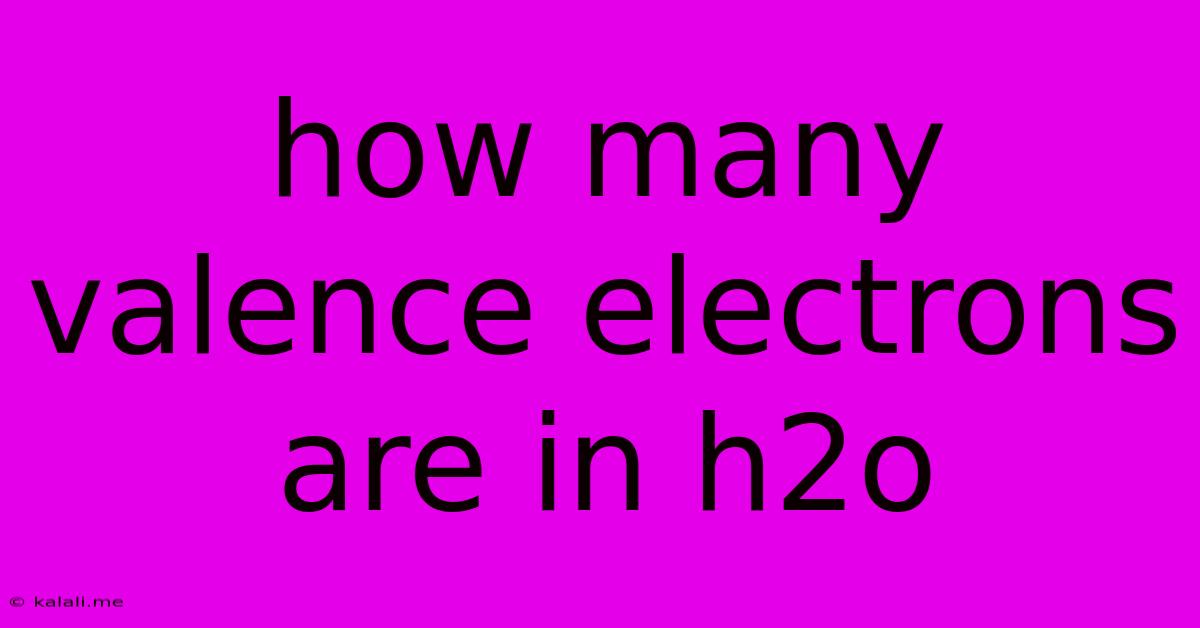How Many Valence Electrons Are In H2o
Kalali
Jun 15, 2025 · 3 min read

Table of Contents
How Many Valence Electrons Are in H₂O? A Deep Dive into Water's Electronic Structure
Water, H₂O, is a ubiquitous molecule essential for life as we know it. Understanding its electronic structure, particularly the number of valence electrons, is crucial to comprehending its unique properties. This article will explore the valence electron count in a water molecule, explaining the concept of valence electrons and how they determine molecular behavior. We'll delve into the Lewis structure and explore the implications of this electron configuration.
What are Valence Electrons?
Valence electrons are the electrons located in the outermost shell of an atom. These electrons are the most loosely bound and are primarily responsible for the atom's chemical behavior, including its ability to form bonds with other atoms. They determine the atom's reactivity and the types of bonds it can create – ionic, covalent, or metallic. Understanding valence electrons is fundamental to understanding chemical bonding.
Determining Valence Electrons in Hydrogen and Oxygen
To determine the total number of valence electrons in H₂O, we need to first look at the individual atoms:
- Hydrogen (H): Hydrogen has one electron in its outermost shell (the 1s orbital). Therefore, hydrogen has one valence electron.
- Oxygen (O): Oxygen has eight electrons in total: two in the inner shell (1s orbital) and six in the outer shell (2s and 2p orbitals). Thus, oxygen has six valence electrons.
Calculating Valence Electrons in H₂O
Now, let's combine the contributions from each atom in the water molecule:
- Two hydrogen atoms contribute 2 x 1 = 2 valence electrons.
- One oxygen atom contributes 6 valence electrons.
Therefore, the total number of valence electrons in a water molecule (H₂O) is 2 + 6 = 8 valence electrons.
The Lewis Structure of Water and Valence Electrons
The Lewis structure visually represents the valence electrons and bonding in a molecule. For water:
- Oxygen is the central atom due to its higher electronegativity.
- Each hydrogen atom shares one electron with the oxygen atom to form a single covalent bond.
- Oxygen uses two of its six valence electrons for bonding with the hydrogens.
- The remaining four valence electrons on oxygen exist as two lone pairs.
This Lewis structure clearly shows the eight valence electrons involved in the bonding and lone pairs within the water molecule. The presence of these lone pairs significantly influences the molecule's bent shape and polarity.
Implications of the Valence Electron Count
The eight valence electrons in H₂O are responsible for its many unique properties:
- Covalent Bonding: The sharing of electrons between oxygen and hydrogen leads to strong covalent bonds.
- Polarity: The unequal sharing of electrons due to the difference in electronegativity between oxygen and hydrogen results in a polar molecule with a bent shape.
- Hydrogen Bonding: The presence of lone pairs on oxygen allows water molecules to form hydrogen bonds with each other, leading to high surface tension, high boiling point, and excellent solvent properties.
In conclusion, the water molecule (H₂O) possesses a total of eight valence electrons, crucial in determining its structure, bonding, and exceptional properties that are essential for life. This understanding is fundamental to various fields like chemistry, biology, and environmental science.
Latest Posts
Latest Posts
-
Which Of The Following Is Not A Strong Base
Jun 16, 2025
-
The Atomic Number Is Determined By The Number Of
Jun 16, 2025
-
Normal Profit Is Also Known As Economic Profit
Jun 16, 2025
-
What Is A Factor Of 50
Jun 16, 2025
-
What Is The First Five Multiples Of 9
Jun 16, 2025
Related Post
Thank you for visiting our website which covers about How Many Valence Electrons Are In H2o . We hope the information provided has been useful to you. Feel free to contact us if you have any questions or need further assistance. See you next time and don't miss to bookmark.